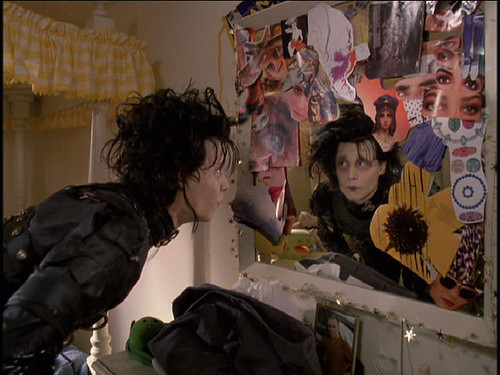Some of the early movies that use Technicolor were
The Wizard of Oz (1939) and
The Blue Bird (1940). The year 1939, was a big year for colored film and
The Wizard of Oz especially, exemplifies this by surrounding everything by color. The reasons
The Blue Bird and
The Wizard of Oz are mentioned is because they both use the same techniques to introduce color to film, yet in a different time and place. Both films start off black and white and then enters the world of color.
I find this shift toward
color very fascinating because, it turns into a movie about color. It also works as an effective way to introduce color to the viewer and to cause a change of emotion or engender a reaction. Maybe the thought process was, once the viewer sees color they will see a whole new beginning for film. Also, for the viewer to possibly be able to quickly form an opinion and distinguish between the two scenes of black and white versus color. Color is explored and is exploited in
The Wizard of OZ to show the viewer how color can be used in a variety of different ways. Just take a look at this
purple horse! When would an audience expect to see a purple horse on television?
Another commonality between
The Wizard of Oz and
The Blue Bird is that color is introduced at the same time as a fairy. Fairies are imaginary creatures and all the viewer’s share the juxtaposition of unreal magic and real color.
 |
| (Fairy with various patches of color) |
 |
| (Fairy with a pink glamorous glittery dress and bright red lips) |
One aspect I thought was very interesting about
The Wizard of Oz, is the use of nature to represent color. In the beginning of the movie there is a tornado in Kansas during the black and white scenes. Tornadoes remind me of dark colors, dust, and tragedy–the total contrary to her arrival in the imaginary land of
OZ. Dorothy finally concludes “We must be over the rainbow.” Dorothy realizes she left a gray dull place to a place such
like a rainbow, filled with beautiful colors and magic everywhere.


Interestingly enough, the use of Technicolor’s magic was not wasted at any moment. In
The Wizard of OZ novel, the slippers are silver. The film was possibly very eager to show off Technicolor’s magical appearance on television and made them ruby and glittery.

As far as black and white movies can be mysterious, color movies also work in their own mysterious ways, by touching our emotion based off of the color shown. I agree with cinematographer Vittorio Storaro that color changes your state and it touches the emotion. Color is a powerful form of appeal to the viewer’s emotions. A color image provides realism and despite the land of
OZ being a fantasy, color makes that fantasy seem real.
Just imagine entering the wonderful land of OZ without color. There would not be a point to follow the “yellow brick road.”
It would not be the “yellow brick road” without the help of these three-strip colors red, green and blue to make it happen.
The use of color in
The Wizard of Oz has a meaning and purpose. One of them being the imitation of the three-strip colors, portrayed in the three munchkins who dance and sing in the film.
The use of Technicolor in both
The Wizard of Oz and
The Blue Bird was artfully portrayed in the film. Technicolor produced a rich and vivid image of different sceneries and tones for the movies. I think as much as people may have a nostalgia for black and white television movies or programs, according to Marshall McLuhan’s theory it’s the
color that affects everybody and not the content. The fairy in the film
The Blue Bird, says to Shirley Temple: “The blue bird brings happiness,” and that is what color brings – Happiness.























